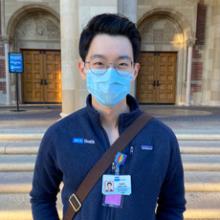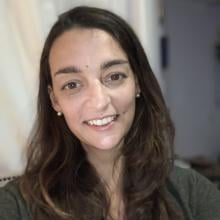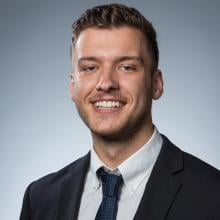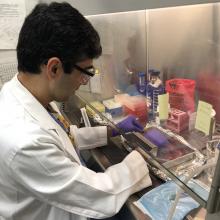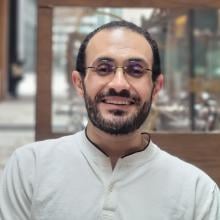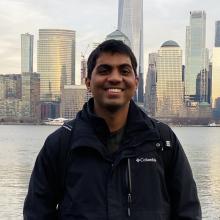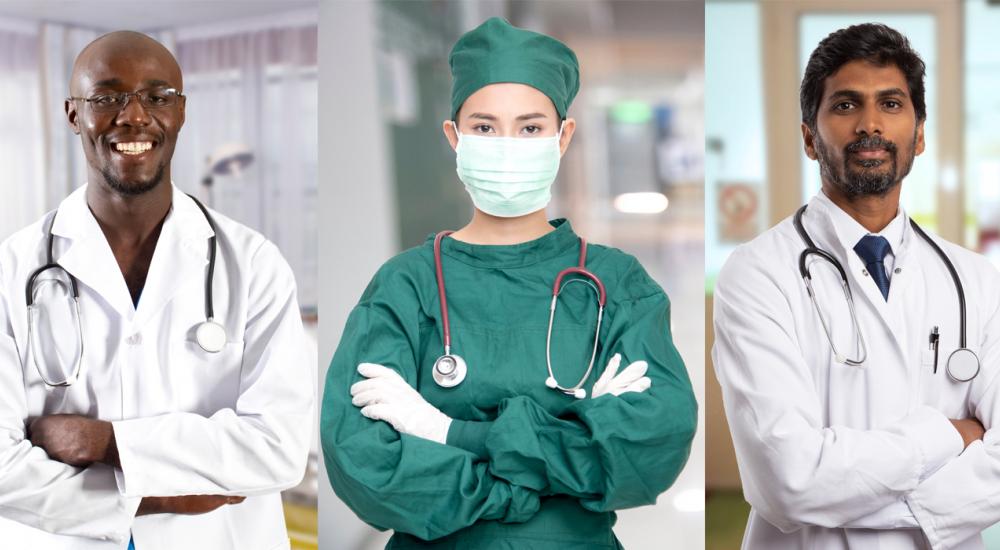“The Right Place at the Right Time”: Eight Former International Students and Scholars Working on the COVID-19 Front Lines
Over the past year, international students and scholars have leveraged their expertise on the front lines of the battle against COVID-19 around the globe, including in the United States. As doctors, engineers, and researchers, they have been critical in the country’s fight against the pandemic through life-saving work in different areas.
“We, as immigrants, try to do everything we can to try and contribute to society," says Nitin Arora, MD, MPH, FAAP, a doctor and researcher from India. "Immigrants are doing their part, not only as physicians, nurses, respiratory therapists and pharmacists, but also in all kinds of jobs across the spectrum.”
International Educator spoke with eight international professionals who have been involved in everything from direct patient care to vaccine research. These individuals have drawn attention to disparities in health outcomes exacerbated by the pandemic, created and processed COVID-19 testing kits when none were available commercially, and developed software to detect COVID-19 from chest X-rays, among other exciting and beneficial accomplishments.
Listen to two of their stories in the April 2021 episode of the International Educator podcast.
Daniel R. Wang, MD
Country of origin: Canada
Medical resident in Ronald Reagan UCLA Medical Center’s Department of Internal Medicine
As COVID-19 crossed the globe in 2020, Daniel R. Wang’s Optional Practical Training extension application was barely making its way through the backlog at U.S. Citizenship and Immigration Services. With the help of Representative Ted Lieu (D-Calif.), the application was processed, and Wang, an international medical graduate, began his residency at the Department of Internal Medicine at the Ronald Reagan UCLA Medical Center last June.
Wang was born in China, spent his childhood in Singapore, and finished high school in Canada. He earned his undergraduate degree at Columbia University and attended medical school at Cornell University.
At UCLA, Wang reached out to the cardiology department because of his interest in health care disparities. He started researching the disparate effect of COVID-19 on Asian Americans. Based on that work, he was the lead author of a paper published in the Journal of General Internal Medicine in October 2020 that focused on the health risks and social factors that Asian Americans encountered during the pandemic.
Oftentimes Asian Americans are lumped together, says Wang, even though there are significant differences between different groups. “We have this massive problem in medicine where we aggregate folks that are intrinsically very different, just because they’re Asian Americans,” Wang says. “Within Asian Americans, we know there’s a huge amount of variation.”
For example, South Asians are at greater risk for cardiovascular disease, Vietnamese Americans are more likely to be uninsured, and more than half of Cambodian American women can’t access health care because of a lack of translators, Wang says. Filipino Americans are highly represented in health care, especially nursing, which also means they’re at higher risk for exposure to COVID, he added.
“My goal is to highlight disparities that we know exist, but that are now a disaster worsened by COVID. This could be the linchpin for some ongoing efforts to then address [those disparities].” —Daniel Wang
“My goal is to highlight disparities that we know exist, but that are now a disaster worsened by COVID,” Wang says. “This could be the linchpin for some ongoing efforts to then address [those disparities].”
Wang is also working on the UCLA COLHEART-19 trial, which looks at whether colchicine—an anti-inflammatory medication—offers any protective mechanisms for COVID patients in relation to inflammation surrounding the heart.
As a resident, Wang has not worked in the COVID ward, but he has seen COVID patients in the emergency room. “The whole point for us as residents is that we are exposed to a variety of pathologies,” he says.
Wang says that doing his residency during the pandemic has changed the way he perceives medicine. He has seen the different levels of care patients receive based on the resources different hospitals have. “It’s very sobering,” he says. “I think 5 to 10 years from now, we’re going look back and say, ‘Wow, we learned a lot.’”
Hear more from Wang on the International Educator podcast.
Ana Costa Monteiro, MD, PhD
Country of origin: Brazil
Pulmonary and critical care fellow at the University of California-Los Angeles
When Ana Costa Monteiro came back from maternity leave in April 2020, she returned to working at a hospital at a time when relatively little was known about how COVID-19 was transmitted. And because of her work as a pulmonary and critical care research fellow at the University of California-Los Angeles, she and her colleagues in her specialty were in high demand.
“In the beginning, it was very stressful not knowing about your own safety and the safety of your family and your newborn child,” she says. “It was also very sad in the sense that the outcomes aren’t good for a lot of our minority [patients]. It was a majority Latin American population, which is where I’m from. And I saw a lot of the suffering of families, and that really resonated with me.”
Over the last year, Costa Monteiro, who attended medical school at Emory University, has split her time between researching COVID outcomes and treating COVID patients in the ICU. Her research focuses on acute respiratory distress syndrome (ARDS), which is an inflammation that makes it difficult for the lungs to absorb oxygen.
“I was already working on ARDS, which is very relevant to COVID,” Costa Monteiro says. “ARDS is the big thing that kills people with COVID.”
Costa Monteiro also worked through the end of the COVID-19 surge that hit Los Angeles this past winter. She says that she had a lot of support from colleagues, but “as a group of critical care physicians that have gone through this, we do have a lot of trauma,” she says. “We talk about all the people that we saw saying goodbye to their families over Zoom.”
“As a group of critical care physicians that have gone through this, we do have a lot of trauma. We talk about all the people that we saw saying goodbye to their families over Zoom.” —Ana Costa Monteiro
The experience of working with COVID patients during the pandemic will define the rest of her career, says Costa Monteiro. She points to Anthony Fauci, the immunologist who serves as the director of the U.S. National Institute of Allergy and Infectious Diseases.
“He was one of the people who was on the front lines during the HIV pandemic,” she says. “I think that’s going be my generation of doctors, who were the people on the front lines during the COVID pandemic. That’s going to define a lot of what we do and how we do it. And we’re all going to be very comfortable treating ARDS.”
Hear more from Costa Monteiro on the International Educator podcast.
Rilind Radoniqi, MEng
Country of origin: Kosovo
Research associate at Abbott Laboratories
Rilind Radoniqi was just a few months into his new job as a research associate at Abbott Laboratories, a medical device company, when the pandemic hit. “It was my first real job, and I was trying to learn as quickly as I [could],” he says. “But here comes COVID, 3 months later, and honestly, it changed everything. It was a pretty intense first year.”
Radoniqi began his education in the United States at age 15 when he received a full scholarship for Kosovan students to attend a private high school in California. He remained in the United States for college.
As an undergraduate at Whittier College, he majored in biological science and interned at Keck Graduate Institute. “That’s where I started to explore more about the bioprocessing realm, which is the side of manufacturing of pharmaceuticals,” Radoniqi says. He was attracted to bioprocessing because it still had an indirect impact on patients.
While pursuing a master’s in engineering at Keck, he received hands-on training in the laboratory and experience that helped him transition into the workforce.
“But here comes COVID, 3 months later, and honestly, it changed everything. It was a pretty intense first year.” —Rilind Radoniqi
Last spring, his work quickly pivoted to focus on developing COVID-19 tests; he and his colleagues were putting in 60-hour work weeks to meet the demand. Radoniqi focused on developing reagents, the ingredient needed to detect the presence of the virus in a sample. “We act as process engineers to grow cells and produce the ingredient,” he says.
The tests that he helped develop are now available commercially in hospitals. He also worked on a consumer test that is currently going through approval at the U.S. Food and Drug Administration (FDA).
Radoniqi says that working on COVID testing solidified his interest in biotechnology. It “meant everything” to be involved in a collaborative project working toward a common goal that has a direct impact on people’s well-being, he says.
Nitin Arora, MD, MPH, FAAP
Country of origin: India
Assistant professor at Children’s of Alabama and the University of Alabama-Birmingham
Nitin Arora’s academic and career trajectories have been marked by continually seeking new opportunities—and then seizing them. His work during the COVID-19 pandemic has been no exception. Arora’s background in pediatrics and infectious disease has been a helpful combination in his current research, a study of whether or not the coronavirus can be transmitted from mother to baby via the placenta. Known as vertical transmission, it occurs in less than 1 percent of cases, Arora says.
After completing medical school in India, Arora came to the United States to earn a master’s in public health from the University of Alabama-Birmingham (UAB). “I always was interested in a career in pediatrics and wanted to work in child and maternal health,” he says. “The reason I came to the United States was mainly because of the research opportunities.”
During his master’s program, Arora worked on a virus known as cytomegalovirus (CMV), which is the most common nongenetic cause of hearing loss in babies worldwide. The lab where he was working developed a screening test for CMV in newborns using saliva samples. “My research was all related to infectious disease in children and neonates,” he says.
While at UAB, Arora completed the training he needed to practice medicine in the United States and started a pediatrics residency at West Virginia University. He then did a fellowship in neonatology at the University of Pittsburgh Medical Center and studied the role of the placenta in transmission of the Zika virus from mother to baby.
“My goal was to do my part in whichever way I can.” —Nitin Arora
Arora has also been involved in the development of Pneumask, a reusable, modified snorkel mask that functions as personal protective equipment (PPE) for medical personnel. After the PPE shortage became apparent last spring, he got in touch with Manu Prakash, a bioengineering professor at Stanford University, to test out whether or not the mask works in a clinical setting. Prakash and his team are currently working with the FDA to get Pneumask fully approved as an N95-equivalent PPE.
Arora said he was able to apply his knowledge of the ICU, disease transmission and procedures such as intubation to PPE solutions. “My goal was to do my part in whichever way I can,” he says.
Mody Amin, MBBCH
Country of origin: Egypt
Medical student, Émigré Physicians Program at New York Institute of Technology's College of Osteopathic Medicine
During one of his clinical rotations in 2020, Mody Amin began collaborating with colleagues from Yemen on a paper focused on the ways in which COVID-19 impacted countries with limited medical infrastructure. “If rich countries that have well-established health care systems are suffering from lack of resources, what will be the situation back in our countries?” he says.
In Yemen, more than 50 percent of health care facilities have been devastated by the civil war, Amin says. Many health care workers emigrated due to the conflict, and the country primarily relies on foreign labs to process COVID-19 tests.
The paper’s goal was to draw attention to the devastation the pandemic has wrought in countries like Yemen, Amin says. “During this crisis, I think the only way forward is to cooperate together because we have to survive together,” he says.
Amin had to start his medical career over when he relocated from Egypt to the United States. He worked as a family physician in Egypt after finishing medical school in 2008, then spent 3 years working as a general surgeon at a military hospital. Unable to practice medicine in the United States, he tried out various jobs, including being an Uber driver and working in cell phone sales. “In the back of my mind, being a doctor was still there,” he says.
“During this crisis, I think the only way forward is to cooperate together because we have to survive together.” —Mody Amin
After completing an associate’s degree in biology at a community college, Amin applied and was accepted to the Émigré Physicians Program at New York Institute of Technology College of Osteopathic Medicine (NYITCOM). The program is one of the few in the United States that retrains doctors from abroad to allow them to practice medicine in the United States.
Though the pandemic impacted Amin’s second year at NYITCOM—there was a lack of clinical rotations and limited capacity for students to take the board exams required to obtain a medical license—Amin will apply for his residency in September 2021.
Amin describes the transition from being a practicing doctor in Egypt to being a medical student in the United States as “hard and amazing at the same time.” He says a lot has changed since he completed medical school in Egypt, ranging from new treatments to less-invasive surgeries.
“I think that the key point that helped me is from day one, remind yourself, ‘I am a student, I’m not a physician. I’m here to learn and share my experience. I’m here to learn from my professors, my instructors, my fellow students, my friends,’” he says.
Mansi Purwar, PhD
Country of origin: India
Postdoctoral researcher at the Wistar Institute
Mansi Purwar had been working on HIV-related projects with grants from organizations such as the Bill and Melinda Gates Foundation when focus turned to COVID-19 research in spring 2020. Her laboratory quickly began work on a COVID-19 vaccine in collaboration with Inovio Pharmaceuticals.
“It was really crazy,” she says. “We stopped working on everything else and all of a sudden started working on COVID.”
Purwar’s infectious disease research, focused on HIV vaccine design, began when she was a PhD student at the Indian Institute of Science in Bengaluru, India. She came to the United States for a postdoctoral fellowship in 2018. After a brief period at a university laboratory, she joined the Wistar Institute, a biomedical research center with a focus on cancer, immunology, and infectious disease.
Prior to the pandemic, Purwar had worked on assays, which are protocols that measure the effectiveness of an immune response to a vaccine. She joined a team working on assay development for Inovio’s DNA-based vaccine, which is currently undergoing clinical trials. In comparison to the RNA-based Moderna and Pfizer vaccines—currently used with emergency authorization from the FDA—DNA-based vaccines are more cost effective and can be stored at room temperature.
“It challenges you professionally. It means something that [our work] can have a direct application in a very small amount of time.” —Mansi Purwar
While she was happy to return to her HIV research, Purwar was glad she could leverage her expertise to work on a vaccine for the coronavirus. “This is also a great experience, working with COVID, because it challenges you professionally,” she says. “It means something that [our work] can have a direct application in a very small amount of time.”
Luan Vu, PhD
Country of origin: Vietnam
Postdoctoral research fellow at Louisiana State University
When the local hospital in Baton Rouge, Louisiana, was unable to order COVID-19 sample collection kits to test for the virus, they turned to Luan Vu, PhD, a postdoctoral research fellow at Louisiana State University (LSU) specializing in respiratory infections. Back in his native Vietnam, Vu spent 5 years working as a public health researcher focused on testing for Dengue fever, a mosquito-borne tropical disease.
Vu, who did his PhD in medicine at the University of Sydney in Australia, drew on his prior experience to manufacture collection kits locally in Louisiana, including making the reagent—a substance that causes a chemical reaction if a virus is present. He says that in Vietnam he had learned how to improvise solutions from scratch. “We turned the basic science lab into a testing development lab,” Vu says.
Overall, his lab created more than 5,000 collection kits. Vu adds that his wife, Anh Phan, helped him make the kits.
The hospital then inquired if Vu’s lab could not only make the testing kits but also process the results. Again, he relied on his experience with diagnostic testing in Vietnam. His lab started processing 100 samples a day, eventually scaling up to 1,000 a day. “I was in the right place at the right time,” Vu says.
Vu has also been collaborating with a mechanical engineer to develop a smartphone-based biosensor that detects COVID-19 antibodies and antigens in body fluids. It would potentially allow people to know within minutes whether or not they are sick with COVID and need to quarantine.
“I was in the right place at the right time.” —Luan Vu
It was his work in Vietnam testing 2,000 samples a day that inspired him to pursue his PhD in immunology. “When I do the testing, I only know the patient ID and result,” he says. “That’s why I wanted to know more about immunity and how immunity fights against viruses. But now it comes back full circle. I’m doing my testing again.”
Barath Narayanan, PhD
Country of origin: India
Research scientist and adjunct professor, Department of Electrical and Computer Engineering at the University of Dayton
When chest X-rays from patients with COVID-19 came across his desk, Barath Narayanan quickly sat down at his computer and started to code. He was able to modify the algorithm that he developed to detect and diagnose pneumonia and apply it to COVID-19. To his surprise, his software was able to analyze chest X-rays and correctly diagnose patients with COVID-19 with minimal false positives or false negatives.
“To be honest, I wasn’t expecting it to work, but that’s how R&D [research and development] works,” he said. “You never know what might or might not work.”
As a research scientist and adjunct professor in electrical engineering at the University of Dayton (UD), Narayanan’s previous work also focused on medical imaging and machine learning. He came to Ohio in 2011 to complete a master’s as part of a dual degree program with his university in India. His PhD research, which he also did at UD, focused on detecting lung cancer and providing second opinions to radiologists during lung cancer screenings using chest radiographs and CT scans.
Narayanan published a journal article and a blog post about the applications of his work for COVID-19 detection, and the algorithm was immediately licensed by Blue Eye Soft, a start-up founded by Srikanth Kodeboyina, who was also a UD graduate.
“It feels really good to contribute what I know to the public using the knowledge we learned in school.” —Barath Narayanan
The software has the potential to assist in regions where COVID-19 testing is limited, Narayanan said. “It feels really good to contribute what I know to the public using the knowledge we learned in school,” he says. •
About International Educator
International Educator is NAFSA’s flagship publication and has been published continually since 1990. As a record of the association and the field of international education, IE includes articles on a variety of topics, trends, and issues facing NAFSA members and their work.
From in-depth features to interviews with thought leaders and columns tailored to NAFSA’s knowledge communities, IE provides must-read context and analysis to those working around the globe to advance international education and exchange.
About NAFSA
NAFSA: Association of International Educators is the world's largest nonprofit association dedicated to international education and exchange. NAFSA serves the needs of more than 10,000 members and international educators worldwide at more than 3,500 institutions, in over 150 countries.
NAFSA membership provides you with unmatched access to best-in-class programs, critical updates, and resources to professionalize your practice. Members gain unrivaled opportunities to partner with experienced international education leaders.


